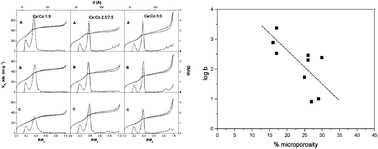Nanostructured, organized mesoporous silicate materials, containing cerium plus cobalt, were synthesized from a system based on polyacrylic acid (Pac), C16TAB and TEOS. The synthesis took place along a titration path from low pH (≈2) to high pH (≈10). Along this path the C16TAB species are attached to the Pac, and on the formed micelles, hydrolysis of TEOS (as well as of cobalt and cerium species) takes place. The initial atomic ratios of Ce(IV) : Co(II/III) were 1 : 9, 2.5 : 7.5 and 5 : 5. In each of those three cases, three different samples were isolated at pH = 5.5, 7.5 and 9.5 which, after drying and firing at 600 °C, were characterized by X-ray diffraction (XRD), nitrogen adsorption porosimetry, diffuse reflectance spectrospopy (DRS), scanning electron microscopy (SEM) and energy dispersive X-ray spectroscopy (EDX). Cerium is already quantitatively incorporated into the solid at pH = 5.5. At this low pH value, only ≈20% of the cobalt is incorporated into the solid, but it is fully incorporated at the high pH of 9.5 The silicate species containing a low content of Ce(IV) and Co(II/III) (x : z = 1 : 9) show a self-organized morphology as previously observed in samples free of cerium. This self-organization is destroyed when the content of cerium is increased (x : z = 2.5 : 7.5 and 5 : 5). The samples with a low content of Ce(IV) and Co(II/III) possess an MCM-41 structure, which is gradually degenerated as the amount of the metals increases, and tiny crystallites of CeO2 and Co3O4 become apparent with XRD. The surface area of the solids was in the range 1230–770 m2 g−1, and it drops almost linearly as the content of the metals in the solids increases with the increase of pH. The I-point methodology was successfully applied to detect and distinguish distinct domains of microporosity and mesoporosity in the solids, as well as for the estimation of the percentage of micropore volumes (%Vmic), found in the range 15–30%, using the variation of the C parameter of the BET equation. The pore anisotropy, b, was also determined in the range 10 < b < 2300. A correlation of the form log b = log b0
− (%Vmic) was observed for the materials of the present study, in line with previous findings.


 Please wait while we load your content...
Please wait while we load your content...